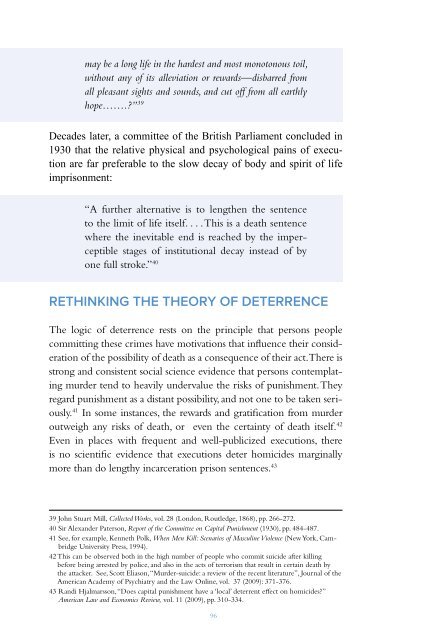PENALTY
DBk0302s7Xm
DBk0302s7Xm
You also want an ePaper? Increase the reach of your titles
YUMPU automatically turns print PDFs into web optimized ePapers that Google loves.
may be a long life in the hardest and most monotonous toil,<br />
without any of its alleviation or rewards—disbarred from<br />
all pleasant sights and sounds, and cut off from all earthly<br />
hope…….?” 39<br />
Decades later, a committee of the British Parliament concluded in<br />
1930 that the relative physical and psychological pains of execution<br />
are far preferable to the slow decay of body and spirit of life<br />
imprisonment:<br />
“A further alternative is to lengthen the sentence<br />
to the limit of life itself. . . . This is a death sentence<br />
where the inevitable end is reached by the imperceptible<br />
stages of institutional decay instead of by<br />
one full stroke.” 40<br />
RETHINKING THE THEORY OF DETERRENCE<br />
The logic of deterrence rests on the principle that persons people<br />
committing these crimes have motivations that influence their consideration<br />
of the possibility of death as a consequence of their act. There is<br />
strong and consistent social science evidence that persons contemplating<br />
murder tend to heavily undervalue the risks of punishment. They<br />
regard punishment as a distant possibility, and not one to be taken seriously.<br />
41 In some instances, the rewards and gratification from murder<br />
outweigh any risks of death, or even the certainty of death itself. 42<br />
Even in places with frequent and well-publicized executions, there<br />
is no scientific evidence that executions deter homicides marginally<br />
more than do lengthy incarceration prison sentences. 43<br />
39 John Stuart Mill, Collected Works, vol. 28 (London, Routledge, 1868), pp. 266-272.<br />
40 Sir Alexander Paterson, Report of the Committee on Capital Punishment (1930), pp. 484-487.<br />
41 See, for example, Kenneth Polk, When Men Kill: Scenarios of Masculine Violence (New York, Cambridge<br />
University Press, 1994).<br />
42 This can be observed both in the high number of people who commit suicide after killing<br />
before being arrested by police, and also in the acts of terrorism that result in certain death by<br />
the attacker. See, Scott Eliason, “Murder-suicide: a review of the recent literature”, Journal of the<br />
American Academy of Psychiatry and the Law Online, vol. 37 (2009): 371-376.<br />
43 Randi Hjalmarsson, “Does capital punishment have a ‘local’ deterrent effect on homicides?”<br />
American Law and Economics Review, vol. 11 (2009), pp. 310-334.<br />
A recent review of the empirical research on deterrence 44 , concluded<br />
that three preconditions of decision-making by criminal offenders<br />
are necessary for deterrence to be effective:<br />
1. Knowledge—Do offenders know and understand the implications<br />
of the law? Do they know which actions are criminalized<br />
and what will mitigate their culpability?<br />
2. Rationality—If so, will they allow that understanding to<br />
determine their conduct?<br />
3. Perceived net cost—If so, are they likely to choose compliance<br />
as the more beneficial option? Is the punishment worth<br />
avoiding? This in turn requires assessment of three concurrent<br />
probabilities: (a) the probability of being caught and convicted,<br />
(b) the likely severity of a sentence, and the marginal increases in<br />
severity for each level of punishment, and (c) the delay in reaching<br />
the final stage of the most severe punishment.<br />
The third precondition raises the most difficult challenges: assuming<br />
rationality in both perception and weighing of risks associated specifically<br />
with execution. In most instances, the risks are remote: Few<br />
murderers are caught, even fewer sentenced to death, and still fewer<br />
actually executed. 45 In the case of drug trafficking, its apparent high<br />
volume suggests that perceptions of risk are realistically low.<br />
For both murderers and drug traffickers, with detection and punishment<br />
uncertain if not unlikely, and with the payoffs of drug trafficking<br />
well exceeding conventional returns, the net cost hurdle is likely to<br />
defeat deterrence. Empirical research has shown that the calculus drug<br />
offenders apply in their decision making renders deterrence simply<br />
a component of their task to be managed and avoided. But it hardly<br />
changes how net costs are evaluated.<br />
There also are personal rewards that alter the rationality of decision<br />
making. Economic necessity, emotional rewards and other non-rational<br />
44 Paul Robinson and John Darley, “Does the criminal law deter?” Oxford Journal of Law, 24 (2004),<br />
p. 173.<br />
45 See, for example, Scott Phillips and Alena Simon, “Is the modern American death penalty a fatal<br />
lottery? Texas as a conservative test”, Laws, vol. 3 (2014), pp. 85-105, doi:10.3390/laws3010085.<br />
96 97


